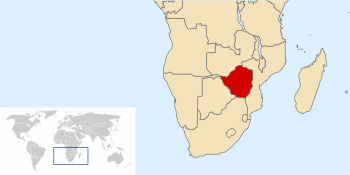Rhodesia facts for kids
Quick facts for kids
Rhodesia
|
|||||||||
|---|---|---|---|---|---|---|---|---|---|
| 1965–1979 | |||||||||
|
|
|||||||||
|
Anthem: "Rise O Voices of Rhodesia" (from 1974)
|
|||||||||
 |
|||||||||
| Status | Unrecognized state | ||||||||
| Capital | Salisbury | ||||||||
| Common languages | English | ||||||||
| Government | Various | ||||||||
| President¹ | |||||||||
|
• 1970–1975
|
Clifford Dupont | ||||||||
|
• 1976–1978
|
John Wrathall | ||||||||
| Prime minister | |||||||||
|
• 1965–1979
|
Ian Smith | ||||||||
| Historical era | Cold War | ||||||||
|
• Independence (UDI)
|
11 November 1965 | ||||||||
|
• Republic declared
|
2 March 1970 | ||||||||
|
• Zimbabwe-Rhodesia
|
1 June 1979 | ||||||||
|
• Zimbabwe
|
17 April 1980 | ||||||||
| Area | |||||||||
| 1978 | 390,580 km2 (150,800 sq mi) | ||||||||
| Population | |||||||||
|
• 1978
|
6930000 | ||||||||
| Currency | Rhodesian pound (until 1970) Rhodesian dollar (from 1970) |
||||||||
|
|||||||||
|
¹ The government recognised Queen Elizabeth II as the official Head of State from 1965 to 1970. The highest official of Rhodesia held the title "Officer Administering the Government" (OAtG) as he acted in lieu of the official Governor, who remained at his post but was ignored. After Rhodesia became a republic in March 1970 the president replaced the OAtG as the highest official, and the Governor returned to London.
|
|||||||||
Rhodesia was an unrecognised state in southern Africa from 1965 to 1979, equivalent in territory to modern Zimbabwe. Rhodesia was the de facto successor state to the British colony of Southern Rhodesia, which had been self-governing since achieving responsible government in 1923. A landlocked nation, Rhodesia was bordered by South Africa to the south, Bechuanaland (later Botswana) to the southwest, Zambia to the northwest, and Mozambique (a Portuguese province until 1975) to the east.
In the late 19th century, the territory north of the Transvaal was chartered to the British South Africa Company, led by Cecil Rhodes. Rhodes and his Pioneer Column marched north in 1890, acquiring a huge block of territory that the company would rule until the early 1920s. In 1923, the company's charter was revoked, and Southern Rhodesia attained self-government and established a legislature. Between 1953 and 1963, Southern Rhodesia was joined with Northern Rhodesia and Nyasaland in the Federation of Rhodesia and Nyasaland.
The decolonisation of Africa in the early 1960s alarmed a significant proportion of Rhodesia's white population. In an effort to delay the transition to black majority rule, Rhodesia's predominantly white government issued its own Unilateral Declaration of Independence (UDI) from the United Kingdom on 11 November 1965. (The government of the United Kingdom supported Rhodesia's transition to a multiracial democracy.) The UDI administration initially sought recognition as an autonomous realm within the Commonwealth of Nations, but reconstituted itself as a republic in 1970. The Rhodesian Bush War, which pitted the government against two African nationalist organisations, ZANU and ZAPU, intensified in the 1970s, prompting Rhodesian premier Ian Smith to concede to multiracial democracy in 1978. However, a provisional government subsequently headed by Smith and his moderate colleague Abel Muzorewa failed in appeasing international critics or halting the bloodshed. By December 1979, Muzorewa had replaced Smith as Prime Minister and secured an agreement with the militant nationalists, allowing Rhodesia to briefly revert to colonial status pending elections under a universal franchise. It finally achieved internationally recognised independence in April 1980 as the Republic of Zimbabwe.
Rhodesia's largest cities were its capital, Salisbury, and Bulawayo. The white population, which grew to nearly 300,000, dominated the country's politics and economy, though they never made up more than 8% of the total population. Rhodesia developed an economy largely dependent on agriculture, manufacturing, and mining. Its largest exports were chromium, tobacco, and steel. International sanctions put increasing pressure on the country as time went on. The unicameral Legislative Assembly was predominantly white, with minority of seats reserved for blacks. Following the declaration of a republic in 1970, this was replaced by a bicameral Parliament with a House of Assembly and a Senate. The Westminster system was retained, with the President acting as ceremonial head of state, and the Prime Minister, heading the Cabinet, as head of government.
Images for kids
-
Ian Smith signing the Unilateral Declaration of Independence
-
Signing of the Rhodesian Internal Settlement (from left: Bishop Abel Muzorewa, Ian Smith, Jeremiah Chirau and Ndabaningi Sithole)
See also
 In Spanish: República de Rodesia para niños
In Spanish: República de Rodesia para niños






